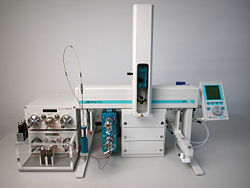MALDI Applications
From LEAP
| Line 1: | Line 1: | ||
{{LSApp | {{LSApp | ||
|name = MALDI Applications | |name = MALDI Applications | ||
| - | |image = | + | |image = MaldiOverview.jpg |
|type = '''STANDARD AND SPECIAL''' | |type = '''STANDARD AND SPECIAL''' | ||
|id = | |id = | ||
Revision as of 02:03, 12 May 2009

| MALDI Applications |
| Application Type | |
| STANDARD AND SPECIAL | |
| Application ID | |
| Description | |
| MALDI Applications |
Matrix-assisted laser desorption/ionization (MALDI) is a soft ionization technique used in mass spectrometry, allowing the analysis of biomolecules (biopolymers such as proteins, peptides and sugars) and large organic molecules (such as polymers, dendrimers and other macromolecules), which tend to be fragile and fragment when ionized by more conventional ionization methods. It is most similar in character to electrospray ionization both in relative softness and the ions produced.
The ionization is triggered by a laser beam (normally a nitrogen laser). A matrix is used to protect the biomolecule from being destroyed by direct laser beam and to facilitate vaporization and ionization.
The sample preparation for MALDI is important for the result. Inorganic salts which are also part of protein extracts interfere with the ionization process. The salts are removed by solid phase extraction or washing the final target spots with water. Both methods can also remove other substances from the sample. The matrix protein mixture is not homogenous because the polarity difference leads to a separation of the two substances during crystallization. The spot diameter of the target is much larger than that of the laser, which makes it necessary to do several laser shots at different places of the target, to get the statistical average of the substance concentration within the target spot. The matrix composition, the addition of trifluoroacetic acid and formic acid, delay between laser pulses, delay time of the acceleration power, laser wavelength, energy density of the laser and the impact angle of the laser on the target are among others the critical values for the quality and reproducibility of the method.
Contact LEAP
For additional information about this technique please contact LEAP Technologies for detailed information

